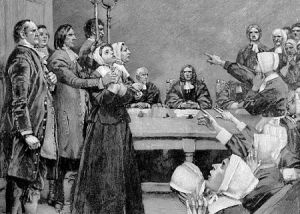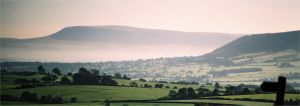 2012 marks the 400th anniversary of the Pendle Witch Trials, among the most infamous witch trials in Britain. In commemoration, a local artist proposed a hillside art installation in Pendle, where the accused witches lived, but local officials ultimately rejected the proposal. Now the artist is defending the integrity of his proposed "witch hunt" art project. Was the decision to reject the project rooted in common-sense considerations, or is this just another case of religious bigotry? We're curious to know what our ordained ministers think--especially those who follow pagan or earth-centered religions.
2012 marks the 400th anniversary of the Pendle Witch Trials, among the most infamous witch trials in Britain. In commemoration, a local artist proposed a hillside art installation in Pendle, where the accused witches lived, but local officials ultimately rejected the proposal. Now the artist is defending the integrity of his proposed "witch hunt" art project. Was the decision to reject the project rooted in common-sense considerations, or is this just another case of religious bigotry? We're curious to know what our ordained ministers think--especially those who follow pagan or earth-centered religions.
Artist Philippe Hanford wanted to paint the number "1612," the year of the trials, on the side of Pendle Hill, a long, low, ominous mound of land stretching across the countryside of Lancashire, a northwestern English county. The installation would have been 500 feet high and 1,400 feet long and stood out in contrast with the green grasses and purple heather of the hillside, making a bold statement to the surrounding farms and hamlets about one of the local region's most significant and tragic historical events. It would have been the artistic highlight of a series of festivities organized throughout the year to commemorate the trials.
Initially Pendle Council and local landowners approved Hanford's proposal, but this decision was reversed under pressure from local religious leaders, residents, and parish councils. Perhaps most prominent among the project's opponents is the Bishop of Barnley, Rt Revd John Goddard. According to the Revd, "[i]t was a wise decision, and I hope the council continues to look for other ways to celebrate our great area." He adds that "[The Pendle Witch Trials] were a dark period of our history which was a matter of injustice." For Revd Goddard, it seems, the best way to confront historical injustice is to ignore it.
 Hanford has contested this reasoning, questioning the motives of the project's opponents. The project, he explains, has passed all the legal hurdles and should have gone ahead as planned. "I still don't know what the objections to the installation were from Barley Parish Council--nobody has given me a specific reason," The Clitheroe Advertiser and Times reports him as saying, adding that "I was also very disappointed with the comments made by the Bishop of Burnley, Rt Revd John Goddard. He says we shouldn't be 'celebrating' the trials, but we're not," and "[w]e're marking the anniversary, hoping it raises wider questions about intolerance and injustice...." As Hanford suggests, it is a mystery why any upstanding member of the community would want to oppose such an endeavor.
Hanford has contested this reasoning, questioning the motives of the project's opponents. The project, he explains, has passed all the legal hurdles and should have gone ahead as planned. "I still don't know what the objections to the installation were from Barley Parish Council--nobody has given me a specific reason," The Clitheroe Advertiser and Times reports him as saying, adding that "I was also very disappointed with the comments made by the Bishop of Burnley, Rt Revd John Goddard. He says we shouldn't be 'celebrating' the trials, but we're not," and "[w]e're marking the anniversary, hoping it raises wider questions about intolerance and injustice...." As Hanford suggests, it is a mystery why any upstanding member of the community would want to oppose such an endeavor.
This sudden change of heart on the part of local leaders remains a mystery, and it begs the question what principles, beliefs, and values backed the reverse decision. Revd Goddard and other opponents of Hanford's art project seem to be creating a straw man argument by confusing the idea of "celebrating" tragedy with that of "commemorating" tragedy. To celebrate means to rejoice, while commemorate means to observe. As Hanford explains, his project is not intended to celebrate tragedy--it is intended to honor the victims of such tragedy. If Hanford is commemorating tragedy, not celebrating it, what is Revd Goddard's motive for opposing the project? The likeliest candidate is good, old-fashioned religious prejudice toward anything remotely "witchy," even if this means ignoring the victims' memories.
Give us your thoughts as a ULC minister. Was Hanford's project rejected out of an irrational fear of witchcraft?
Sources:


Witch back then used to be witch trials then they stop in the year 1693